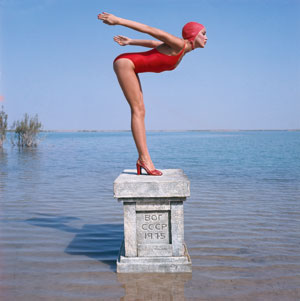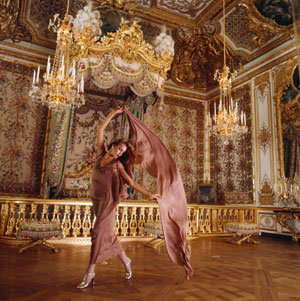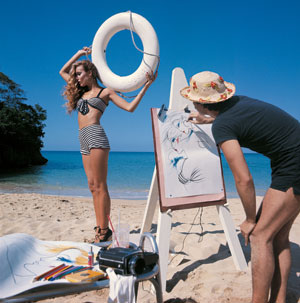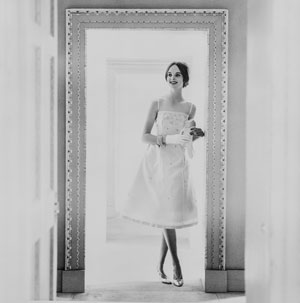Norman Parkinson: legend behind a lens

Simply sign up to the Life & Arts myFT Digest -- delivered directly to your inbox.
Norman Parkinson was one of the great British fashion and portrait photographers of the 20th century. His career began in 1931, when at 18 he was apprenticed to a firm of royal photographers in New Bond Street, and ended with his death in 1990.
He set up his first studio in 1934, and before the war he worked for magazines such as Harper’s Bazaar and The Bystander; during the war he joined the RAF as a reconnaissance photographer and from 1945 to 1960 he worked for Vogue. After moving to Tobago in 1963, he became a freelance photographer, dividing his time between fashion and portraits, running the gamut from members of the royal family to movie stars, politicians and The Beatles. In Tobago, he set up a pig farm, and for years his Famous Porkinsons Bangers were served on Concorde and at The Ritz. He was responsible for the early success of models such as Celia Hammond, Grace Coddington and Jerry Hall, who first worked with him in 1975, when she modelled evening gowns in Versailles and then made a pioneering fashion trip with him to the USSR.
It was after seeing Jerry Hall in one of Parkinson’s photographs that Bryan Ferry asked her to pose (as a mermaid) for the cover of Roxy Music’s fifth album, Siren. After her marriage to Mick Jagger, she and Jagger became close friends with Parkinson and his wife, Wenda, visiting them for holidays in the Caribbean with their children.
On April 21 it will be the centenary of Norman Parkinson’s birth and the BBC Arena has a new documentary film about his life and work.
Here, the film’s director, Nicola Roberts, talks to Jerry Hall about her memories of “Parks”.
…

Jerry Hall: I loved him. He was an old-style gentleman photographer, very polite, very thoughtful – but he wanted the picture. He’d ask if you didn’t “mind doing this, please”, and it was “thank you so much” afterwards, and he had on his little eccentric fez that he thought made him lucky. I met him [in 1975] when I was 18. Our first photo shoot was at Versailles. I had on a bridal gown and was on Marie Antoinette’s bed and we did wonderful pictures down the Hall of Mirrors. He had a sense of “big” – you know, big spaces – he would choose panoramic views and had a great sense of movement across the page. He always enjoyed you moving, doing some kind of a shape, which I really enjoyed, too.
Nicola Roberts: You said that you don’t think there are many great fashion photographers …
JH: Well I don’t, because I think that to be a really great fashion photographer, your pictures have to capture the imagination of people and be timeless, and very few photographers manage to do that. There are lots of photographers who make fashion look great, who make you look beautiful, who sell lots of clothes and do a great job, but they don’t capture a moment in time. That’s a special quality, and I think Parkinson proved again and again that he had it. When you look at his photos, you see how many of them stand out. When they’re made into postcards or posters, there’s always something that you remember. The women seem alive, they’re quirky. I love the pictures he took of his wife, Wenda. They’re beautiful in that sort of “1950s-perfection” way, but something about her seems very intelligent and special.

It’s a shame that so many years went by when people didn’t use him. When I met him he was having a revival, but he hadn’t really worked in years. He was making more money from his sausage factory [in Tobago] than he was from his photographs. I think he was about 70 then – he seemed quite old to me. I became friends with him, as did my husband Mick, and we went on holidays with him and his family. We went to Trinidad and danced at carnival, and won I think it was second place! We ended up getting blind drunk. I actually found myself lying in a gutter. I mean, really, that’s never happened to me before or since, only with Parks.
NR: You said he got you to do quite risky things?
JH: Well, he was always saying, “Climb up on that thing!” I went up on oil rigs in Russia waving giant flags, stood on a plinth in a red swimsuit in the Red Sea. He had me on a horse, bareback, in a blue dress, and the horse took off and threw me into a barbed-wire fence. I broke my tail bone and he came up and said, “You all right?” and I said, “I think so”, blood everywhere. And he said, “I thought you said you were from Texas!” He made me get right back on another horse and do the picture. The next day I was in agony; he [just] said, “Oh God.” Tears were rolling down my face and he was, like, “Come on, stop making such a fuss.” Eventually he did take me to the doctor, but he wasn’t very sympathetic at all. But he had the most profound effect on my modelling career and my life, as far as photographs went. His photos sort of launched me into becoming a big model in England and in America, and I met my fiancé Bryan Ferry because of those photos.
NR: You mentioned the Soviet Union photographs: people didn’t go to the Soviet Union at that point … ?

JH: I think we were the first fashion magazine to have been invited to do photographs in Russia. This was in the mid-1970s and we had to travel around with Intourist guides and they were taking our film. Parks was worried they might not develop the film right, so he asked me to stuff some down my pants, which I did – I was very young. Anyway, we got the film back and then he said to me afterwards, “Actually, the Russians developed the film even better than we did over here and we needn’t have bothered.”
NR: Tell me about some of the other shoots you enjoyed with him. The one in Jamaica? Those are such beautiful pictures.
JH: Grace Coddington was the stylist. She has such a wonderful eye. My partner in the photographs was my then boyfriend, the fashion illustrator Antonio Lopez, who’d kind of started my career, and he had a great sense of style. So we’d worked out what we were doing and Parks just said “great”, and let us do what we wanted. We’re in swimsuits and Antonio has a movie camera and white gloves – this was way before Michael Jackson’s white glove look, so they looked quite strange. But Parks was up for anything – he was like a young person, even though he was quite aged – everything was a new discovery for him, which was exciting because you felt that you were collaborating, you felt free. I was so excited when I was working with him; I would go to bed thinking, what will I do tomorrow?

NR: He photographed you and [the model] Iman together more than once, didn’t he?
JH: He did, and we were great friends, so it was lovely to work with him. He would do these things that could have been really tacky, but he made it work. We would be wearing black and white clothes, we’d have black and white French poodles, we’d be sitting on a white bench … in Paris, in the Tuileries Gardens. It really worked.
NR: Can I ask you about the photograph in the National Portrait Gallery, of you and Mick Jagger?
JH: It’s in the National Portrait Gallery? Am I topless?
NR: Yes.
JH: Ah, shocking! That’s naughty. That was supposed to be for us. We did these pictures and he said, “OK, let’s just do one where you take your top off, just for you,” and he did give me a print of it which is beautiful. But of course, it was too good not to share.
NR: Do you think that’s a good portrait?

JH: I think it’s lovely, a wonderful photo, really lovely, except my boobs are showing!
NR: Was it of any consequence that he was a royal photographer? There is a crossover between royalty and celebrity. Did that make a difference, having your portrait taken by him?
JH: I think it showed the royal family had good taste …
NR: What other things do you remember?
JH: Well I was especially touched by how much he loved his wife – the way he was always looking after her. She came on many of the trips and he was always concerned that she was happy and having a good time, and I think he was a very good husband. I liked that about him.
NR: How would you describe his personal style?
JH: Oh, very elegant. He was very, very tall, and wore these brocaded vests and bow ties, and the fez and the moustache that curled up. He was like somebody from another era. Just a really lovely guy – I never had a bad time with him, even though some pretty awful things happened, but I don’t think I ever said “No”.

NR: What was it like working with him on the Town & Country [a US lifestyle magazine] shoots?
JH: I forgot about all those! We went to amazing houses with people who had wonderful art collections. I remember asking at one house, “Where did these people get all their money from?” Apparently the grandfather or great-grandfather had invented the can-opener. That was a good one!
NR: As an American yourself, do you think Americans loved Parkinson’s Englishness? Did he ever ham it up a bit?
JH: I think they adored it because it was like watching Poirot or something – I definitely think he hammed it up. I mean, why not? In fashion no one cares about the truth as long as it’s a good story. Everyone just wanted things to be fun and exotic.
NR: Was he ever possessive about the models he worked with? It’s said he wasn’t keen on them working for other people.
![Wenda and [the Parkinsons’ son] Simon, south of France, c1951](https://www.ft.com/__origami/service/image/v2/images/raw/http%3A%2F%2Fcom.ft.imagepublish.upp-prod-eu.s3.amazonaws.com%2Feb7ff7a0-9686-11e2-9ab2-00144feabdc0?source=next-article&fit=scale-down&quality=highest&width=700&dpr=1)
JH: I think by the time I’d come along he was resigned to it. By then, girls had started to be more international. It wasn’t the way it used to be, where you’d just be in London working with one or two photographers. And once that happened, I don’t think he could say anything because we were off …
NR: Did you notice things getting glitzier and gaudier in the 1980s?
JH: Well, the 1970s were pretty glitzy. I hated that shoulder pad thing – it was just so ugly and didn’t suit me at all. So I preferred the 70s to the 80s, because of those hideous shoulder pads.
NR: So Parkinson could take you, a young Texan girl, and put you in Versailles and make you look, as they say now, as if you owned it. He could do that?
JH: Yes, because there’d always be a story. I enjoy a story, too, and you’d always have to have it in your head. So when I was sitting on Marie Antoinette’s bed, it was all about it being a ghost of Versailles. He just had a way of making you feel very confident and alive and special. There was such a connection. I think part of what made his pictures so amazing was that he had an idea he’d worked out in his head, something slightly poetic, and he also had an intensity of focus and all the technical ability, so the combination … Sometimes, like everyone, he would take pictures that were OK, but more often than not he took really great pictures.
NR: Was there a difference between Parkinson, the photographer, and Parkinson, the man?
JH: When he was taking pictures he was very professional, but “the man” was equally as charming, as polite. But he did enjoy telling stories. I mean, he’d been on so many wonderful trips and he was a great raconteur and he enjoyed drinking wine and having a good time. So there was a big difference, yeah. He could let his hair down.
NR: The word that comes up repeatedly is “gentleman” …
JH: He was a real gentleman, always. And he was a very talented photographer. It was very sad when he passed away. But I must say, he had a great career.

——————————————-
The Arena film, ‘aka Norman Parkinson’, directed by Nicola Roberts, will be broadcast on BBC4 in April. ‘Lifework: Norman Parkinson’s Century of Style’ runs at the National Theatre’s Lyttleton’s Exhibition Space on the Southbank until May 12. ‘Mouvements de Femmes’, an exhibition of Parkinson’s photographs curated by the designer Roland Mouret, is at The Octagon, Bath, from April 12 to May 12. An exhibition of Parkinson’s prints, Norman Parkinson: A Centenary Celebration, is at Chris Beetles Fine Photographs, 3-5 Swallow St, London W1, from April 9 to May 4
——————————————-
Norman Parkinson by Grace Coddington

In 1959, Grace Coddington was training to be a model and working in The Stockpot, a café on the King’s Road, when a customer suggested she audition for a fashion shoot with his friend Norman Parkinson. She got the job, and went on to work with him, first as a model – the photograph at right shows her winning British Vogue’s model competition in 1959 – and then as a fashion editor for Vogue. Here she describes going with Parkinson to photograph Prince Charles, before his investiture in 1969, and explains why, for her, Parkinson was such an inspiring photographer.
…
GC: I went with him to photograph Prince Charles and that was one of the funniest days of my life. He took me along basically to hold his hand because I think he was nervous – this was the future King of England. And he was concerned that Charles would be a little ruddy in the face, so he’d asked me to bring some make-up. I’m not a make-up artist but he didn’t want people around who might capitalise on being close to the prince … This was for his investiture picture, so he wasn’t yet the Prince of Wales. But, you know, you think it’s very funny until the day and then you arrive and you’re waiting, waiting for the guy to come in, and then he comes in and you kind of lose it. I lost it. I was trying to curtsy and shake his hand all at once, and you’re supposed to call him “Your Royal Highness” and no words came out. But Parkinson was very cool and handled himself like you have to in front of royalty. He always had fun taking his pictures – it was always a pleasure and you learnt so much. He taught me the whole modelling thing – though I was not his favourite model, I definitely wasn’t. But he did do my first picture and then later, when I became a fashion editor, I did a lot of my early shoots with him. I knew that Vogue’s editor, Beatrix Miller, felt very comfortable sending somebody like me with, let’s say, not too much experience, on a huge trip with him, because she knew he was always in control and was a very responsible person and would always come back with wonderful pictures.
NR: In interviews, Parkinson comes across as this amateur, “Oh, I just take snaps …”
GC: Yes, he always called them “snaps”, he didn’t make a big deal of it. But photography didn’t have a value at that point, it wasn’t really considered art, it was a job – an extremely nice job.
NR: What were the qualities you noticed in his pictures?
GC: I think I noticed them because of the wit – other photographers didn’t have that wit or looseness, they were much more rigid. He was one of the first people to break that whole rigid look in fashion photography.
NR: Where does sex fit into Parkinson’s photographs?
GC: I never think of them as sexy. I think the girls look beautiful, but they’re not sexy like Helmut Newton’s, which were all about sex. Parkinson’s pictures weren’t all about sex – and even if they’re nude, they weren’t all about sex.
NR: You didn’t like his 80s pictures – the Town & Country period?
GC: I hated them. And I hated that it was him doing them. I think it was a kind of “I’ll show you” attitude –“I’m not done for yet.” But I didn’t see charm in his pictures in that period. And for me, charm and Parkinson are like a marriage. What I saw is vulgarity, and that made me sad. In a way he came full circle. He’d started out as a society photographer, and ended up … But they were people from good families. Those people in Town & Country were just rich people for the sake of being rich. And not even pretty most times.
NR: Is Parkinson one of the great photographers for you?
GC: For me, certainly one of the great photographers. Apart from a very deep love of him, I think his pictures are very inspirational. He inspired me from the day I was 10 or 11, through my modelling period, through my early days of being a fashion editor. He is still inspiring me. He taught me everything I know. He really did. I always say he’s my number one mentor, and I adored him.
——————————————-
‘Grace’ by Grace Coddington is published by Chatto & Windus, £30
Comments